Thinking and Being Green in the Garden
Posted on Sunday, June 5, 2022 · Leave a Comment
Do you want to be a better steward of the environment? If so, the first step is to be a gardener: grow some of your own vegetables, plant some native trees, shrubs and flowers while using no chemicals. But there is even more to think about than what kind of tomatoes to plant, and how many.
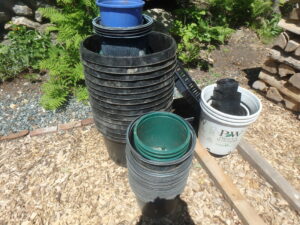
I will deliver these to a garden center that will reuse them.
First, what should you do with all those black plastic pots that come with the plants? Most recycling facilities do not accept black plastic pots, but some pots are numbered #2 or #5, and can be recycled. A few have no numbers. Plastic pots are made from oil in factories around the world. I imagine that these factories spew and spill a certain amount of chemicals, and create waste and by-products that are bad for the environment.
My mantra for plastic is this: Refuse, Re-use, Recycle. So how do you refuse to buy plants in plastic pots? Start your own plants. If you save plastic pots and rinse them out, you can re-use them. Some for years. You can also buy peat pots and coir (palm fiber) pots. Some companies like Gardeners Supply sell sturdy flats to use instead of those flimsy 6-packs, but strong enough to be used many times.
Trees and shrubs are most often sold in big black plastic pots. But they are also sold “balled and burlapped”. Those are usually bigger trees that are dug up and wrapped in burlap after years growing in the ground. Some local nurseries still dig their own plants, and I recommend supporting them. When you plant, be sure to take off any burlap and wires that may be holding the root ball together. And beware of any “fake” burlap made of plastic. Don’t buy it.
For years we have been offering sturdy plastic pots to our local, family-owned garden centers. Most just want them cleaned before you drop them off. I find it easiest to do that right after planting, before the soil bakes on. Re-using pots saves the garden centers money, assuming they have the time to sort and store them. Tell those that do how happy you are with them.
Recycling is really not the answer: Many loads of plastic at the re-cycling center are contaminated and end up in the landfill or incinerator. Too much dirt, food, or items of the wrong number can condemn a whole dumpster of plastic.
I was pleased to learn that most Home Depot stores now accept all kinds of plastic pots. I went to the one near me in West Lebanon, NH and there was a rack outside with the plants just for returned pots. The pots don’t even need to have come from them.
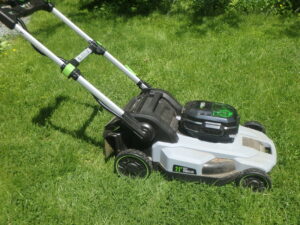
Electric mowers have improved greatly in the past few years. They are quiet and non-polluting.
We recently took a big step forward towards being “Green”. We bought an electric lawn mower. I’ve read that the EPA estimates that using a lawnmower is 11 times more polluting than driving a new car. One hour of mowing, apparently, is equal to driving 93 miles. Of course, these statistics are not perfect, as they do not indicate what kind of mower or car is being compared. Older, bigger mowers are worse.
We bought a 21-inch, self-propelled battery-powered lawn mower on sale for $500 at our local True Value Hardware store. It has a quick-charge battery charger that takes an hour or less to recharge the 54 volt battery, which is good for an hour of mowing. The mower has plenty of power and is so much quieter than our old gas mower. Our lawn takes more than an hour to mow, but so what? I have plenty of other garden chores to do while the battery re-charges. The technology in batteries electric mowers really has improved just in the last few years.
Being Green also means using no chemicals in the garden. That’s an easy one. I don’t use herbicides, insecticides or chemical fertilizers. I don’t want something to kill dandelions or moss, neither of which I consider a problem.
There are perfectly wonderful organic fertilizers that offer so much more than the chemical ones. Instead of just offering three plant nutrients (nitrogen, phosphorus, potassium), they offer calcium, magnesium, and many more nutrients plant use. They do this because they are manufactured using natural ingredients like sea weed, cotton seed meal, ground oyster shells and ground peanut hulls.
Organic fertilizers are also slow-release fertilizers. Pro-Gro, made in Vermont, has about 25% soluble nitrogen that is ready right away. The rest is released slowly as microorganisms break it down and make it usable by plants. And it will not damage root hairs the way some of the chemical fertilizers can if too much is applied.
Compost is one of the best things you can add to your soil. It helps sandy soils hold moisture and loosens up heavy clay-based soils. You can buy it by the bag or –better yet – by the truck load. Even though my soil is terrific, I add compost every year. It is not a fertilizer, but it feeds the microorganisms that work with our plants. And if you get a good grade of compost, it will improve the texture of your soil, not matter what it is.
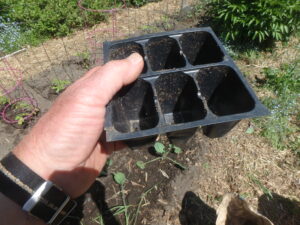
Re-use these 6 packs yourself or bring them to a vendor who accepts them
Lastly, speak up. If your suppliers are trying to reduce use of plastic, or are taking it back to re-use it, tell them that is why you are buying from them. If they’re not? Ask them to! Every voice counts. We gardeners should be on the cutting edge of reducing plastic and chemical use.
Plants That Thrive in Wet or Moist Places
Posted on Wednesday, May 25, 2022 · Leave a Comment
I like to say that plants can be as fussy as a two-year old facing a plate of overcooked broccoli. Plants know what they want, and will not behave the way you want them to unless you accommodate their wishes. Today, let’s look at a few that love wet feet.
First, please understand that plants need oxygen but do not get it from their leaves. No, they get oxygen from their roots. Some plants have evolved ways to get their oxygen despite sitting in water-logged soil while others quickly drown or develop root rot. If you have heavy clay soil that holds water, be sure to pick plants that can tolerate wetness.
I have a small stream running though my property so much of my land stays quite moist, even in dry summers. In spring I often have standing water between raised beds in the vegetable garden. Yet I have plenty of wonderful flowers that thrive here. Here are a dozen I like, arranged roughly according to bloom time, from early spring to late fall.
- The drumstick primrose (Primula denticulata) blooms in early spring in hues of blue to red or white. Then comes P. kisoana that spreads by root in either wet or dry places. Last, starting now, there is the candelabra primrose (P. japonica) which sets out a series of blossoms on an increasingly tall stem over a month of bloom-time. All love growing under old apple trees in dappled shade.
-
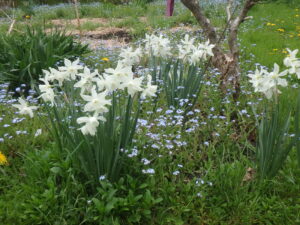
Thalia with Forget-Me-Nots
Forget-Me-Nots (Myosotis sylvatica). I have these blooming now by the hundred everywhere I look, sun or shade. These lovely low-growing blue (or sometimes pink or white) flowers self-sow bountifully. They prefer rich moist soil and will do well in sun or shade. Because they come back from seeds so easily we let them bloom, then often pull them out like weeds to plant something else.
- ‘Thalia’ daffodil. Most bulbs require good drainage, but ‘Thalia’ does fine in soggy soil. She is nearly white, and each bulb can produce three flowers at once. She blooms with the forget-me-nots. Order now for fall planting.
- Globeflower (Trollius spp.). An early summer bloomer, it does best in part sun and moist soil, but will also grow in ordinary garden soil and in full shade. The blossoms are an inch or so across, and bright yellow. Blooms in late May to June, but may sometimes re-bloom in the fall.
- Japanese iris (Iris ensata). These beauties will bloom in standing water, or in damp soil. They are like the Siberian iris, but their falls (petals) lay back almost flat. Blues and purples. Early summer.
- Cardinal flower (Lobelia cardinalis). These flowers are native plants the bloom on 3-foot stalks in fire engine red! I’ve seen them growing on the banks of the Connecticut River, but do well in moist soil and full sun in my garden. Will tolerate some dryness, but prefer wet. I avoid modern hybrids which are other colors, but not as hardy.
-
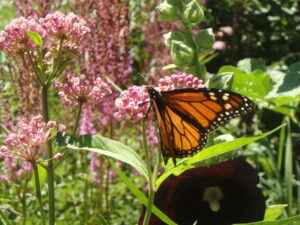
Pollinators are attracted to Swamp milkweed by color and scent
Swamp milkweed (Asclepias incarnata). Related to ordinary milkweed, this likes moist soil and full sun. Unlike the wild one, this does not send runners out and spread by root. Mine get 3- to 5-feet tall, and come in pink or white. Readily available at garden centers.
- These flowers come in red, pink and white and various heights. They can survive in drier soil in shade, but really love moist, rich soil and full sun. good cut flower with an almost woody stem.
- Goldenrod (Solidago spp.). There are many species, some of which spread by root, others do not. It is the very best perennial for supporting pollinators. Mid-summer to fall. ‘Fireworks’ is my favorite.
- Joe Pye Weed (Eutrochium purpureum). This is a native plant that thrives on stream beds and swampy areas that has bee domesticated. A cultivar known as ‘Gateway’ is the best, but gets to be over 6-feete tall. ‘Baby Joe’ is supposed to be a smaller version, but I haven’t tried it yet. Pollinators love this plant which blooms in fall with pinky-purple blossoms.
- Turtlehead (Chelone lyonii). Gorgeous tall stems loaded with pink flowers shaped like helmets – or turtle heads. Will do sun or shade, loves moisture but will grow in ordinary gardens, too. Bumblebees force themselves inside, and seem to growl in there at times. Great cut flower. Fall.
-
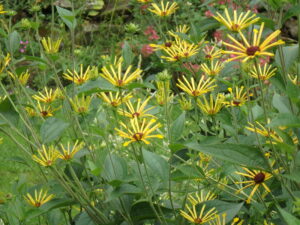
Henry Eiler rudbeckia does well in a moist, sunny location
‘Henry Eiler’ Rudbeckia. One of the latest flowers I grow. Petals are distinctive: they have space between each one, like missing teeth. Tall, often 6-feet or more. Needs to be staked early, or perhaps cut back in early June to reduce height. Blooms past frost. Full sun, rich moist soil.
If you have a clay-based soil that is sticky when you rub it, wet, between your fingers, you would do well to add compost to the soil before planting any of these lovely flowers. Yes, they like the moisture clay holds, but compost – a shovel or more mixed into the planting hole – will improve their performance.
I’m pleased to report that our new young dog, Rowan, is learning to stay out of garden beds. He’s an 18-month old golden/Irish setter mix with lots of energy. But so far, he hasn’t dug up any plants.
Henry lives and gardens in Cornish Flat, NH with his wife, Cindy Heath. Reach Henry at
henry.homeyer@comcast.net or PO Box 364, Cornish Flat, NH 03746.
Getting Rid of Invasives
Posted on Thursday, May 19, 2022 · Leave a Comment
Well intentioned people of the past century imported many handsome plants. Unfortunately, some of them – absent the predators of their homeland – became pests here in America. These “invasives” generally spread quickly by seed and root, and can take over our gardens and adjoining wild places. Many will grow in sun or shade in wet or dry soil – in other words – anywhere!
This is a good time to work on removing as many invasives as you can. You can obtain the entire list on-line as each state keeps a list of plants that are considered invasive and are prohibited from sale, propagation or transportation. But let’s look at a few that are common and important to remove, no matter where you live.
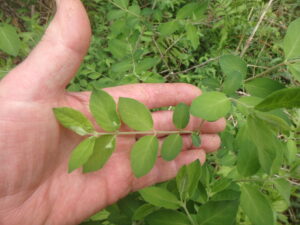
Honeysuckle leaves are oval and opposite each other on the stem
For me, those include bush honeysuckle (Lonicera spp.), barberry (Berberis thunbergii) and common buckthorn (Rhamnus cathartica). I recently organized a work day on a hiking trail in Cornish that focused on honeysuckle and barberry. We tried to pull these shrubs by hand, but also used a device called a weed wrench for bigger specimens.
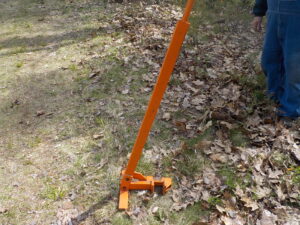
A weed wrench allows anyone to pull out invasive shrubs
Although weed wrench is used generically, it was in fact a trade name, but the company has gone out of business. Similar tools be found under the name “Pullerbear”, “Uprooter” and perhaps others. I have used Weed Wrenches, but not other brands. These are steel tools with sturdy handles and a gripping mouthpiece that bites onto the stem of a shrub up to 2 or 3 inches in diameter, depending on the model. You pull back, and with great leverage you pull out the culprit, roots and all. Some brands come in different sizes.
Many invasive plants are hard to eradicate because if you leave a part of the root in the ground when pulling it out, it will re-sprout. And simply cutting down an invasive tree or shrub usually will often not work: the roots will send up new shoots, and may respond by sending up many, many new shoots.
But don’t be discouraged if you can’t get all the roots out. You are severely setting back the plant you pulled and it will be several years before the plant can produce seeds for birds to distribute elsewhere.
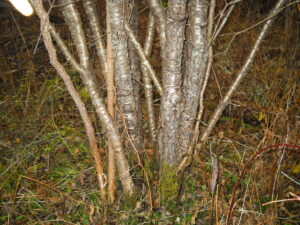
Buckthorn often grows with several stems in a tight grouping
Buckthorn is one of those that responds to cutting by sending up many new plants. Instead of one buckthorn or a clump of buckthorn, you get dozens of buckthorn. But you can kill buckthorn by girdling the trunk. Take a small pruning saw and cut through the bark all the way around the trunk. Don’t cut into the hardwood, just cut the bark. Then go 12 inches higher up, and do it again.
Girdling a buckthorn is a slow death: you are interrupting the flow of sugars from the leaves to the roots, which slowly starve to death. I have done this in winter, and the tree leafed out and seemed normal that spring and the next spring. The third spring it never leafed out – it was dead, and did not sent up any new sprouts around the tree.
That said, it is not always easy to girdle buckthorn. They often grow with several trunks that merge near the base and grow tightly together. So a folding saw with a pointed tip is the best way to get into the cluster of stems. Or try to cut the clump twice down low, near the base.
During the recent work day in Cornish, I spoke with someone who explained a theory of invasive plant control that made a lot of sense to me. It was a theory proposed by Dr. Steve Dewey of Utah State University, and was based on the way firefighters approach wildfires. When a fire is raging, sometimes all you can do is try to contain it, and look for places where the wind has sent sparks that are just starting a new fire.
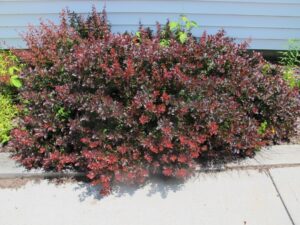
This barberry planted at our posts office has red leaves, but most have green ones. All have thorns and red berries in winter
Likewise, when there is a bad infestation of an invasive plant like honeysuckle or barberry on a property, look around for spots where a single small plant is growing. It will be easier to pull than a big one. And within a few years, a small plant will be a big plant producing seeds for birds, wind or water to move to a new location – and to produce a big patch. So put out the glowing ember first, then work on the big fire – or infestation – next.
An easy invasive plant to pull is garlic mustard. This is a biennial weedy plant and might not be thought to be so bad. But its roots produce a toxin that kills beneficial soil fungi that will, in time, reduce tree viability. It can grow in deep shade in our forests. The toxin it produces will eliminate the mycorrhizal fungi that live in symbiotic relationship with our trees, gradually weakening the trees – and killing them. Not only that, garlic mustard inhibits the germination of seeds of many species of native plants, including many spring wildflowers.
As a biennial weed, garlic mustard has two forms. In the first year it produces a low rosette of rounded leaves. The second year it sends up 18- to 36-inch flower spikes with pointy, heart-shaped leaves with jagged edges. The small white flowers have 4 petals and bloom in clusters about an inch or more in diameter. One plant can produce about 4,000 seeds. And although about 70% of the seeds will germinate the next year, some will remain viable in the soil for up to 10 years.
So organize a work party in your town – it’s more fun than taking on invasives on your own. Try to remove any one of the invasives that threaten our woodlands and wetlands. Your grandkids will thank you one day.
Planting the Vegetable Garden
Posted on Tuesday, May 10, 2022 · Leave a Comment
Every gardener has an opinion about when to start planting the vegetable garden. Frost hardy plants like spinach, onions and peas should already be in the ground for most everyone, but tomatoes and peppers? I believe that waiting until June is right for my garden –even if we get no more frost.
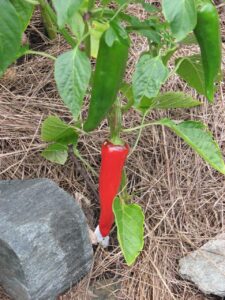
Artichoke ready to pick in my garden
Why do I plant later than many others? Tomatoes and peppers like warm soil. In fact, they’d rather be growing in Mexico than Cornish Flat. Yes, you can plant them early but they won’t grow much. They’ll sit there and sulk. If you can get your hands on a little soil thermometer, check your soil down 3 or 4 inches. If it is 60 degrees or more, fine. Have at it.
Another way to decide when to plant is to ask an “old timer”. Ask someone in your neighborhood when it is safe to plant various crops. If she has been gardening in your neighborhood for the last 25 years or more, her advice is probably excellent.
If you started seeds indoors, your tomatoes or broccoli may be tall and lanky. So tall that they will fall over when planted. The solution? Plant much of the stem in the ground – either in a deep hole for the root ball, or sideways in a shallow trench. Remove and low leaves to make it look like a little palm tree. Then make a hole for the root ball with a 6-inch trench next to it. Lay the tomato seedling in the ground, and gently turn up the top while covering the stem with soil. All the buried stem will produce roots. Broccoli or other brassicas I just plant deep if they are too tall.
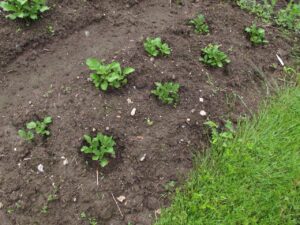
Potatoes ready to hill
Potatoes can go in the ground now unless your garden is still soggy. In fact, don’t plant anything in soggy soil. I have somewhat soggy place for my garden, but make raised beds which helps with drainage. I have made two kinds of raised beds: raised mounds (30-to 36-inches wide) or wood-sided raised beds. I use rough-sawn hemlock planks that are a full inch thick and 8 inches wide. Pressure treated wood is now said to be safe to use in the vegetable garden, but I prefer untreated hemlock which I find lasts about 10 years.
Potatoes are started from chunks of sprouted potatoes, or from whole, small potatoes. Buy “seed potatoes” at your local feed-n-grain store, hardware store of garden center. Grocery store potatoes are likely treated to avoid sprouting, although organic potatoes are probably fine. Seed potatoes are sold as disease free, which is important. If you cut large potatoes into chunks, make sure each has a couple of “eyes” where they will sprout stems. Leave them in a shady, breezy place for a day or two to heal the cuts.
Loosen the soil well, and dig a hole with a hand tool. You want the spud to be at least 3-inches deep when planted as the new potatoes need space to grow above the seed potato. Cover with just an inch of soil at first, but then fill the hole with more soil after the leaves and stems are up above the soil level.
Peppers and eggplants I plant as small plants in mid-June. To give them even more warmth at night I sometimes cover them with row cover (a thin agricultural fabric sold at garden centers). And I’ve been known to place dark-colored rocks near some special French hot peppers I grow to store heat during the day and kick it back at night. Peppers and eggplants can be wind-pollinated, but bees help, too, so don’t leave row covers on once they start blooming.
Parsnips I plant by seed in mid-June, and they generally take 2 weeks or more to germinate. Most seeds are good for 3 years, but you must buy parsnip seeds every year. Like all root crops, parsnips benefit from having loose soil with few rocks (Oh, sorry, Vermonters).
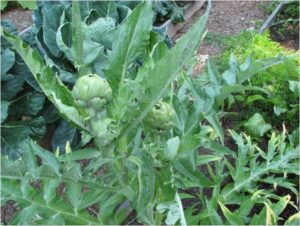
Artichoke ready to pick in my garden
Be sure to thin all root crops in early July once they are big enough to grab onto. Give the carrots an inch to start, then in a month later, thin to 2 inches. You can eat the thinnings. Beets, same thing. And beet greens are delicious.
What about unusual veggies? I like to buy an artichoke plant at my local greenhouse. I have started them from seed, but it is long process starting in February. Give your artichoke a 2-foot square of space, add lots of compost and a little organic fertilizer, and place it in full sun. Make sure it does not dry out. It will produce one good-sized artichoke at the top of the plant, and smaller ones as side shoots. The foliage is lovely, so you can plant one in your flower garden!
Swiss chard is pretty enough to sneak into your flower beds. Get ‘Bright Lights’ chard, which has red, yellow and green stems.
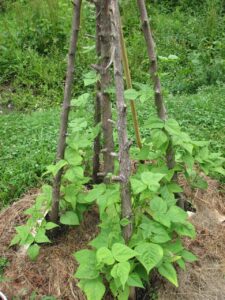
Artichoke ready to pick in my garden
Beans come as bush beans or pole beans. Bush beans all ripen over a 3-week period and are then done. Pole beans, if you keep on picking them, will keep producing until frost. ‘Kentucky Wonder’ is the classic pole bean, though ’Kwintus’ is my favorite. It’s good eating, even when large.
A word of caution about fertilizers: more is not better. Chemical fertilizers can burn fine roots. And too much organic fertilizer can push growth too fast. Compost is always a good addition to your planting hole.
I never use insecticides in the garden. Their side effects can be awful for you, your kids or pets. Just hand pick bugs, or spray off little things like aphids with a stream of water.
Spring Flowers I Love
Posted on Tuesday, May 3, 2022 · Leave a Comment
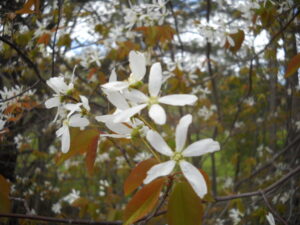
Shadbush in bloom
Spring has teased us this year: she comes, she goes; warm sunny days are followed by high winds, cold rain and even pellets of ice. But the spring flowers persist, starting with those dainty white snowdrops that appear reliably in early March for me. Let’s look at a few – bulbs, shrubs and trees. Perennials I will do on another day.
Snowdrops (Galanthus spp.) bloom with white blossoms on short stems in early March, but seem a bit depressed, I think. They always turn their faces down to the ground. I have some “double” snowdrops that really are gorgeous, but I only see their extra petals when I bend down and turn their faces up. Probably not worth a dollar a bulb, which is what they cost. Snowdrops tend to naturalize, becoming more numerous each year and moving out from flower beds and into the lawn.
After the snowdrops come Glory of the Snow (Chionodoxa luciliae). These are cheerful blue, pink or white flowers that look up to look at me. Sometimes I think they wink at me, saying, “Hey dude, look at us. We are spring.” I mainly grow the blue ones. These naturalize well, spreading quickly.
Related to Glory of the Snow, but more intense in color and attitude, come Siberian squill, most commonly referred to by their scientific name, Scilla (Scilla siberica). They are a deep purple, and their faces point down, looking at their sneakers.

Winter acconite blooms about the same time as snow drops
Along with those flowers come a bright yellow one, Winter Aconite (Eranthis hyemalis). These are low-growing, upward facing flowers with 5 to 8 petals (actually sepals, but who cares?). Like the others, they tend to spread and increase in number. Order some now, along with the others mentioned, and plant them in the fall.
You know crocus, but you might not know that there are 80 or more distinct species of crocus. Some are very early, others bigger and later. Go on line and look at all the varieties. These are good for early pollinators hungry for pollen and nectar.
Daffodils are mildly poisonous to rodents and deer, so they avoid them. Mine are now in full bloom. There are 13 classes of daffies, each quite distinct. Tulips are flavor treats for deer, and rodents love the bulbs. So maybe you should grow them as potted flowers. Or take your chances. Having a several cats will help tulip bulbs survive, and a dog will keep the deer away. My favorite is ‘Maureen’, a 24 to 28-inche tall late bloomer, but I love them all!
Most trees do not have showy blossoms. Why not? Most are wind-pollinated, so do not need to attract pollinators with flashy blossoms or great fragrances. You might never have noticed the blossoms of pines or oaks or maples. Actually, you must have seen red maples (Acer rubrum) bloom. They are early, one of the first trees to blossom. The blossoms are small and fuzzy in appearance. But there are so many blooming at once, you will notice them if you hike in the woods in April.
But of the showy trees, the best in my opinion, is a hybrid magnolia called ‘Merrill’ or ‘Dr. Merrill’ (Magnolia x loebneri ‘Merrill’) named after the Director of the Arnold Arboretum at Harvard in 1952, but actually bred by Karl Sax. It blooms reliably for me in the last week of April and into May. The blossoms are double, fragrant, and 2 to 3-inch across.
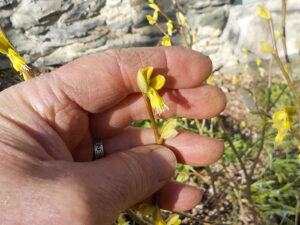
Leatherwood blossoms
This week my leatherwood bush (Dirca palustris) is in bloom with heart-stopping beauty. It is a small native shrub that blooms in dry shade for me. It has lovely gray bark much like beech trees and yellow blossoms that appear before the leaves. The blossoms are small and elegant, and almost seem to glow. It is not a common shrub for sale in nurseries. Mine has upward growing branches in a vase-shaped arrangement. I love it and visit every day when in bloom.
Then there is February Daphne. Well, maybe it blooms in New Jersey or Virginia in February, but it blooms in April for me. It has lots of small pink-purplish stemless blossoms up its branches. It is highly fragrant. It is only 3- to 5-feet tall and wide, and rarely needs pruning. It is native to Europe and Asia, not here, and is said to spread by seed distributed by birds. But in 20 years I have never seen a volunteer on my property. Some people react poorly to the sap, and the berries are toxic if eaten by humans. It likes a part sun-part shade spot.
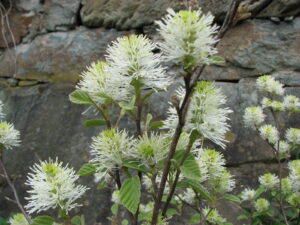
Fothergilla major blooms in May
Perhaps a better shrub to choose would be a fothergilla, which is native and early. There are 2 species, Fothergilla major and F. gardenia, also known as dwarf fothergilla. It has wonderful white bottlebrush flowers in May and best of all, it has fabulous fall foliage color. Red, orange, purple and yellow leaves on one plant! It is not a fast growing plant, and rarely needs pruning.
Another early bloomer and a great producer of berries for birds is small tree or large shrub called shadbush, serviceberry or by its scientific name, Amelanchier spp. I see them blooming along the roadsides in May, nice small white blossoms that remind me of wild apple blossoms. It has nice gray bark, and they often grow as multi-stemmed plants. I have a few, but the fruit is eaten by birds before I ever get to it.
Spring Lawn Care
Posted on Friday, April 29, 2022 · Leave a Comment
It’s about the right time to do a little work on your lawn if it needs it. According to Paul Sachs, the owner of North Country Organics and the author of several books on lawn care, if you want to fill in bare spots, wait until the lawn greens up after winter. And then have at it.
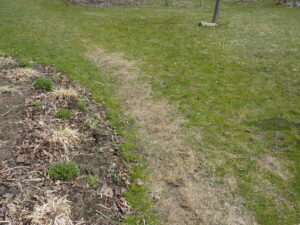
This dead spot was caused by too many footsteps when wet
To fix bare spots I use a short-tined garden rake to scuff up the soil. Then I scatter some seed with my hand, just sprinkling it over the spot. Next I sprinkle a thin layer of compost or fine garden soil over the seed. Not too much: most grasses need sunshine on the seed to germinate. Bury it with an inch of soil, and it won’t do well. Finally, pat it down with your foot, lightly, or with a metal tamper.
It’s important that the seed not dry out while it is getting ready to grow, so often people shade the seed with a fine layer of hay or straw. Of course hay has seeds, so straw is better, albeit more expensive. You can leave the straw and just let the seed grow through it. Later, when you mow the lawn, it will disappear.
Why do places in your lawn need help? Most lawn grasses do not like to grow in compacted soil. So if you park cars on the lawn, or walk over it every day on your way to the mailbox, it will get compacted. Enter (drum roll) CRAB GRASS. Crab grass will grow in compacted soil, but it is an annual so it dies each winter – or by late summer if gets too dry. The solution is simple: build a stone path to the mailbox and park cars only in designated parking areas.
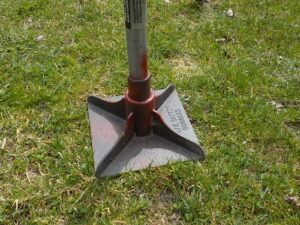
This tamper is useful for lightly packing down seeded areas
Let’s re-think the concept of a lawn. Why do we need a large patch of short grass at an even height all around our house? Sure, people with kids and dogs need some place to play ball or Frisbee. And if you like to have friends over and sit around a barbecue grill, a little lawn is nice. But do you really like mowing an acre of lawn once a week, or paying someone else to do it? Maybe it’s time to reduce the size of your lawn and plant some more native trees and shrubs.
Entomologist Doug Tallamy is the author of a terrific book called Nature’s Best Hope: A New Approach to Conservation That Starts in Your Yard. Dr. Tallamy suggests that we can help birds and pollinators by growing native trees and shrubs – and by adding more to replace some lawn, especially in new subdivisions and in-town lots.
Birds depend on the caterpillars of moths and butterflies to feed their young. He determined that 6,000 to 9,000 caterpillars are needed to feed a clutch of chickadees from hatching to fledgling. That’s an amazing number of caterpillars, especially since most of us never even notice them.
Those butterflies and moths will mostly only lay their eggs on trees and shrubs they know: our natives. Even if your barberry or burning bush has been growing in your yard for 50 years, they probably will ignore it and look for an oak, a cherry or a willow – trees they evolved with them over tens of thousands of years.
Dr. Tallamy makes a great suggestion about how to think about lawns: think of lawn as you might throw rugs, not wall-to-wall carpeting. Bump out with trees planted along the edges of your property line, reducing the lawn with native trees. Create nice curves, then add some understory shrubs along the edge of the newly “forested” area.
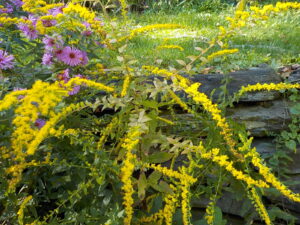
‘Fireworks’ goldenrod is commonly sold in nurseries now
In addition to the oaks, native cherry and willow trees, other “keystone” trees include birches, poplars (he calls them cottonwoods) and elm. He said just 5% of the genera of plants support 75% of the caterpillars. Great perennials include goldenrod (the absolute best), asters, and members of the sunflower family. There are many tame goldenrod species that will not take over your garden, so expand your plant palette to include “Fireworks” goldenrod and other nice varieties.
But back to lawns: my philosophy of lawns is this: If it is green and you can mow it, it’s a lawn. It need not be free of dandelions and Creeping Charlie. Yes, dig out thistles, or anything that hurts your bare feet. But violets? Sure, why not? Anything that blooms will provide nectar or pollen for bees and other pollinators.
Clover actually helps your lawn, despite being called a weed by the companies that promote using the “Weed-n-Feed” chemicals that kill it. Clover fixes nitrogen, taking it from the air and putting it into the soil, reducing a need for lawn fertilizer.
If you want a rich, lush lawn, don’t cut it too short. The longer the grass, the more food produced to grow grass roots. The deeper the roots, the better the lawn will be at surviving drought.
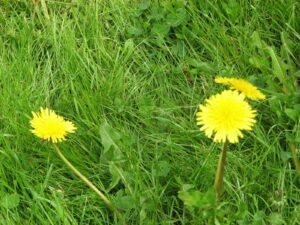
Dandelions in lawn help feed pollinators early in the spring
When you add grass seed to fill in spots, I recommend a mix of seeds, not a pure Kentucky bluegrass, which is the neediest of all grasses. It needs fertilizer, and watering. A “Conservation Mix” will do better for you. And if you are planting in a shady area, get a mix made for shady places. Those sun/shade mixes are not as good for shady areas as those designed for them.
Soil pH is a measure of soil acidity. If you are serious about your lawn, buy a kit at the local feed-and-grain store or garden center to test the pH. If you have chlorinated water, buy some distilled water to use with the kit. If the soil pH is lower than 6.2, add some lime (ground limestone) to your soil to bring up the number. Lawns don’t do so well in highly acidic soil.
When I see a weed-free lawn, I know it‘s been treated with chemicals, and I won’t walk on it barefoot. You, your kids and dogs shouldn’t either.
Growing Vegetables to Share with All
Posted on Tuesday, April 19, 2022 · Leave a Comment
I recently went to Brattleboro, Vermont, to meet with the organizers of Edible Brattleboro. It is an informal group of people who believe that “access to fresh healthy food is a right for all, regardless of means. This serves as the basis of the work we are doing, and we do our best to eliminate barriers to benefiting from our work, and thus everything we offer is free.”
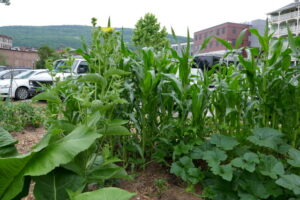
Edible Brattleboro garden at Brattleboro Coop last summer
The prime movers behind this movement are Tom Green and Marilyn Chiarello, who have been working to turn empty spaces and lawns into places for food production. Both are retired school teachers. Marilyn saw a TED talk by Pam Warhurst in 2015 and decided that something similar could be done in Brattleboro.
That first year Edible Brattleboro approached the local food cooperative and asked for a strip of land between the parking lot and the Whetstone Brook. The Coop agreed, and volunteers built a 4 x 8-foot raised bed. They have since expanded this space, growing strawberries, tomatoes, herbs and more. Volunteers plant, weed and water as needed. Anyone can help themselves to the free food, there are no questions asked.
By now there are gardens and fruit trees all over town that were started by Edible Brattleboro. I went around with Tom and Marilyn and looked at some of their projects. Three cherry trees are planted in front of the town hall, and other fruit trees are planted on school property. Another garden is at an addiction recovery center, Turning Point, where there are raised beds in the front lawn.
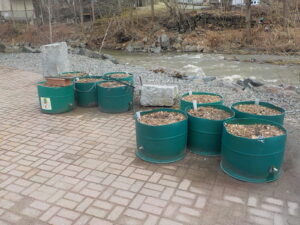
These drums with water reservoirs will be full of vegetables later this summer
Another garden is at the Root Social Justice Center, at the edge of their parking lot. Volunteers made container gardens using food grade plastic 55-gallon drums using designs Tom found online. They have water reservoirs so that water wicks up into the soil in the drums, and daily watering is not needed. Tom also got some one-cubic meter “intermediate beverage containers” that originally held sugar syrup. Again, he fitted them with water reservoirs to avoid daily watering.
Edible Brattleboro has had good luck getting small grants to support their activities. Although not a 501-C3 themselves, they work under the auspices of Post Oil Solutions, a local non-profit that sponsors them. But they will work with any organization that will help in their efforts.
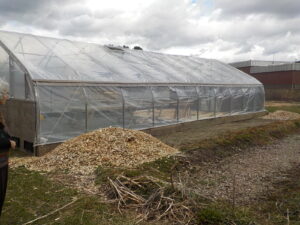
Volunteers built this greenhouse that was paid for by a grant
Often low-income residents do not have the tools they need to garden. Fortunately, in Brattleboro that is not a big issue as the town library has a “lending library” of tools and kitchen equipment that they furnished with a grant from the Vermont Foodbank. The library’s grant included money to purchase a simple wooden structure in their parking lot to house the tools, and a part-time librarian to check out tools at specified times. For beginning gardeners, having a source for the basic tools can be an important saving.
We also visited a large green house for extending the season and growing things like tomatoes and peppers in a controlled environment. Tom Green and volunteers put it up this winter, and they look forward to using it shortly. It sits on space offered by the Brattleboro Retreat Farm, a non-profit.
There is a weekly Farmers Market in Brattleboro and Tom and Marilyn couldn’t say enough good things about the generosity of the farmers. At the close of the market each week volunteers from Edible Brattleboro visit the market and collect produce donated by farmers. They got a grant to buy a large refrigerator to hold perishables, and have an outdoor “Share the Harvest” table the next day at Turning Point.
So what can you do? All communities have both needy people and gardeners. What is needed in most town are people like Tom and Marilyn. People with a commitment to helping, time, and organizational skills. Except for Tom’s work building the green house and large self-watering containers, no special skills were needed for what they have done.
Some sort of organizational structure is needed. I like the idea of joining up with an existing non-profit so that grants and donations can be made to a certified 501-C3, allowing donors to take tax deductions. That also lets people know that their money will be used properly.
There are organizations you could link up with, perhaps. You probably already know about soup kitchens and food banks in your town, or a nearby town. So, you could plant a little extra this year with the idea of sharing. Or you could help to organize others in your area to join with you.
Churches are another good place to start gardens. They generally have lawns in full sun, and people who want to help others. The soil in any lawn generally needs improving, but I bet most farmers would be delighted to donate some compost or composted cow manure to add to the soil. Garden centers are generally willing to donate some seeds or seedlings when the time comes, or perhaps a few bags of compost. So all you need is people-power. I bet you will be gratified at how willing others will be to help. So GET STARTED!
Henry plans to share fresh veggies
this year with Willing Hands, a non-profit that serves his town with food for the needy. Reach him at PO Box 364, Cornish Flat, NH 03746 or
henry.homeyer@comcast.net.
Spring Activities in the Garden
Posted on Friday, April 15, 2022 · Leave a Comment
I’ve finally had a few days of dry weather with temperature in the 50’s, so have been able to start some spring cleanup. Some of my beds are still too wet, so I will wait on working there until my feet don’t sink in. Walking on wet soil compacts it, ruining soil structure.
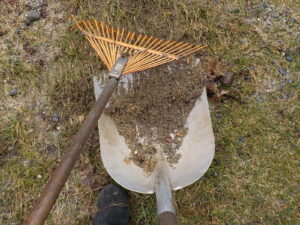
This aluminum shovel is lightweight and good for cleanup
My first chore is always to rake up the sand and gravel that the snow plows leave on my lawn. I use a straight-edged shovel that is made of aluminum and is sold for barn cleanup. I rake the sand into the broad shovel, and dump it into a wheelbarrow. If I see that the grass is being pulled up, I wait until later, when the grass has fully woken up.
Next on my list is to pick up any downed branches. Winter always does some “pruning” of dead branches. If I can reach any jagged tears where branches have broken off, I snip or saw them back to the trunk or the branch where it originated. And this is a good time to take of those plastic wraps that protect young trees from mice and voles.
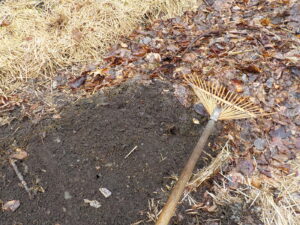
Remove mulch in the vegetable garden to allow soil to dry and warm up
I don’t generally rake leaves out of my flower beds in the fall, as I like the extra protection against erosion and cold temperatures they provide. But that means that bulb plants are covered now, and the ground is insulated from the spring sun. I want the soil to warm up. So I try to clean up places where I know there are spring bulbs as early as possible.
If the daffodils are poking through, I use my fingers to pull back the leaves. I fear that a rake will damage the tender stems and flower buds. In other places where bulbs are not up yet, I use a rake and gently rake off the leaves. Sometimes I will bring along a scrap of plywood or a 6-inch plank to stand on as I work, minimizing compaction.

Blueberry fruit buds are fat, leaf buds are not
This is when I prune blueberry bushes. By now it is easy to identify the fat, round fruit buds as opposed to the skinny little leaf buds. I remove branches that aren’t producing fruit, allowing for more sunshine to get into my plants.
For the past few years a foreign fruit fly has badly damaged blueberry crops. The spotted-winged drosophila (SWD) infests ripening fruit, causing it to get mushy and unpleasant. This is in contrast to ordinary, native fruit flies that only lay eggs in over-ripe or rotting fruit.
At present he only way I know that organic growers can prevent damage is to cover bushes with row cover or a very fine mesh. But that is a big bother when it is time to start picking. The SWD appears fairly late in summer, so early-ripening varieties can sometimes avoid them.
Of course if you haven’t cut back all your perennials, spring is a good time to do that. I like to wait until spring to cut back some perennial flowers with seeds. Finches and other seed-eaters enjoy the seeds, particularly when bigger, greedy and aggressive birds or squirrels are hogging the seeds at the feeder.

It’s too late to rake here. I’ll remove leaves by hand to avoid damaging buds
In the fall I usually do a good job of weeding and mulching the vegetable garden with fallen leaves or straw. In the spring I rake the mulch of my wide raised beds so that the sun can help to dry out and warm up the beds. I leave the mulch in the walkways to inhibit weeds, and later I will add new mulch around my tomatoes and other plants.
My roses haven’t woken up yet, or not by the time I wrote this, but will soon. I have a dozen or more roses and most are very hardy. I particularly like the ‘Knockout’ rose series. They are very resistant to diseases, do not seem to attract Japanese beetles or rose chafers, and are very vigorous. But each spring I need to cut back the canes to a point where the tissue has not been winter damaged.
You can easily tell if the stems of your roses are alive by rubbing a stem gently with your thumb nail. If it shows green, it is alive. If it is not green, it is dead. Cut back any stem to a place where there is a bud on tissue that is alive. Or you can wait until they leaf out, and cut back the dead parts. If you have a few shoots that got much taller than the rest of the plant, you should cut those back for aesthetic reasons.
Spring is also a good time to pay attention to the “volunteer” shrubs and trees that show up uninvited. There are several invasive species that birds plant seemingly “willy-nilly” anywhere they perch. Seeds pass through them and start growing without your help. But you should pull these shrubs and trees before they get so big you need a backhoe!
Here are some to look for: bush honeysuckle (Lonicera spp.), barberry (Berberis thunbergii), burning bush (Euonymus alatus), Autumn Olive (Elaeagnus umbellate), Blunt-leaved privet (Ligustrum obtusifolium) and the vine Oriental bittersweet (Celastrus orbiculatus). Norway maple (Acer platanoides) and common buckthorn (Rhamnus cathartica) are trees that also common and invasive.
Why worry about invasives now? They are more obvious in the landscape. Most get a jump on the growing season by putting on leaves while our native plants are still asleep. Plus, you have time now. So go dig them out if you can. Cutting them down usually just stimulates them to set up many new plants from their roots.
Later, when spring warms up, we will be planting our veggies and annual flowers so we won’t have time for many of these activities. So get out there on the next nice day.
Now is the Time to Buy Tubers and Rhizomes for Summer-Blooming Flowers
Posted on Tuesday, April 5, 2022 · Leave a Comment
I like dahlias. They are bright and come in many colors with blossoms from the size of daisies to the size of dinner plates. My wife, Cindy, LOVES dahlias. Every year we have discussions about how many we should plant and where they might go. I believe there is a thing as too many dahlias. Cindy does not.
Each fall we dig up our dahlias a week or so after the first hard frost but before the ground freezes. We store them in a cool basement in boxes filled with sphagnum moss or sawdust that is lightly moist. The problem is, each plant produces a dozen or more tubers, and each and every one will produce a new plant the next summer.
If you have purchased dahlia plants at a greenhouse in the past, maybe this year you would like to try planting some tubers. They tend to be less expensive, and there is definitely more variety. Go to your local garden center or go on-line and order tubers.
Choose a 6-inch pot and fill it three quarters full with potting soil. Place the tuber so that it is lying flat on the surface, and cover with a few inches of potting soil. Pat it down, water lightly, and let it be. When it is ready, it will send up shoots and then it will need some bright lights. They have tiny “eyes” or growing points, and if you can spot one, be sure to plant it on the top side. But eyes are not always easily identified.
I grow ours on a plant stand with fluorescent lights, and have never tried them on a bright windowsill, but I guess that would work, too. If you find your plants on a windowsill are floppy or pale, switch to artificial lights if you have them.
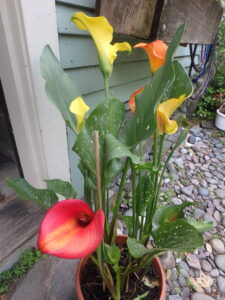
Calla lily growing in a pot on my front steps rotated
I LOVE calla lilies. These beauties are not true lilies at all, but members of the Arum family (which includes Jack-in-the-Pulpit, skunk cabbage and the house plants Dieffenbachia and Philodendron). Calla lilies are perennial in warm climates, but, like dahlias and gladiolas, must be dug and brought inside before the winter here. Now is the time to start some calla rhizomes (a bulb-like modified stem) indoors. Plant them with the smooth side down.
One of the advantages of growing calla lilies is that they are not true lilies, hence not bother by that dastardly red bug, the lily-leaf beetle. The lily-leaf beetle attacks Oriental and Asiatic lilies that I do so love, but have given up growing. Calla lilies also bloom for a much longer time than true lilies, though they lack the fragrance of Oriental lilies.
To start calla lilies indoors now, buy rhizomes now at your local garden center or from a reputable supplier. The rhizomes need to be planted about 3 inches deep, then covered with potting mix. It is a good plant for people who tend to overwater their houseplants, as they thrive in moist soil. (By the way, start doubling the water to your rosemary plants if you over-wintered any. Otherwise they will dry out and die).
Once summer is here you can either transplant your potted calla to a nice sunny spot, or you can keep it in the pot and move it outside. Come fall, you will need to bring them inside, as temperatures around 20 will kill them. Callas need to go dormant in winter.
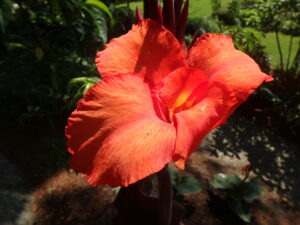
This Canna lily has purple leaves and stands nearly 6 feet tall
When buying some calla lily rhizomes at my local garden center, I also bought some gladiolus corms (commonly called bulbs). My gardening grandfather loved growing gladioli, and won ribbons at the Worcester, Massachusetts county fair most years.
Gladiolus corms are relatively inexpensive so most gardeners don’t bother saving them. Classic colors are red, yellow, pink and purple. I recently bought bulbs that will produce flowers with pink, white, and white with pink designs at my local garden center. I will wait and plant them directly in the soil in my garden in June.
Another summer beauty is the canna lily. We grew some that were six-feet tall last summer and they bloomed from mid-summer till fall. Buy rhizomes now and start them indoors to get a good jump on the season. They come in various sizes, and with green or purple foliage.
My favorite summer bulb plant is called a variety of common names: peacock orchid, sword lily, or fragrant gladiolus (even though this plant is not an orchid, a lily or a gladiolus). That’s why I like Latin names. If you ask for Acidanthera murielae, plant-knowledgeable people around the world will know what you mean. But for now, I’ll refer to it as sword lily.
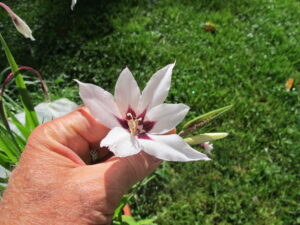
Sword lilies are highly fragrant in the evening
The sword lily has long, narrow leaves – like swords- that stand 18 inches or more tall. The blossoms are white with deep purple markings in the center of the 6-petaled flower, along with a little yellow at the very center. You get 2 or 3 blossoms per stem, and they are enticingly fragrant, particularly in the evening. I’ll plant them now, 8 to 12 bulbs three inches deep in a 12-inch pot and grow them on the deck this summer.
I don’t know about you, but I need all the green growing things around me I can get as mud season lingers on. So get your summer bulbs now, before they are all sold out and start a few indoors.
Growing Nuts and Berries
Posted on Tuesday, March 29, 2022 · Leave a Comment
Every year you probably plant tomatoes. Wouldn’t it be great if they would come back every year without the bother of preparing the soil, starting seedlings in April and setting them out? Well that’s what nut and fruit trees and berry bushes do: once planted (and mature), they produce food every year. To me, there is a definite allure to plants requiring less work.
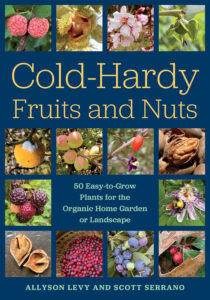
Cold Hardy Fruits and Nuts cover
I recently was sent a review copy of a wonderful book by Allyson Levy and Scott Serranno: Cold-Hardy Fruits and Nuts: 50 Easy-to-Grow Plants for the Organic Home Garden or Landscape printed by Chelsea Green Publishing (all photos supplied by the authors). When I got it I could barely pull myself away from it because it has so much to teach me.
Each of the species included has five or six pages devoted to it, and at least five excellent photos. The information starts with “Growth Difficulty Rating” – how hard is it to grow? Most are easy. It includes taste profile and uses, pollination requirements (is it self-pollinating?), site and soil conditions, zone hardiness, good cultivars to look for, and a paragraph on pests and problems, and more.
I called the authors and asked about their experience growing this diverse group of plants. They live in Stone Ridge, NY, a town about 100 miles north of NYC and 10 miles or so from the Hudson River. They are in Zone 6 where winter temperatures only go a little below zero most winters.
They are both artists, and originally started growing plants to use in their art. About 20 years ago they bought 8 acres across the street from them, and started their own arboretum, later adding another 10 acres. Their arboretum is Hortus Arboretum and Botanical Garden and is a Level II arboretum according to the Morton Arboretum.
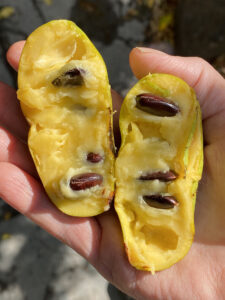
Pawpaw cut fruit in hand
I asked them what they would recommend for fruit if someone had none, and wanted to start with winners. Scott suggested blueberries and blackberries. Both are easy and tasty. Elderberries are good, too, they said, although you need to cook the berries to make them palatable. Elderberries, honey and lemon juice make a nice syrup which I use to help prevent colds in winter.
We talked about honeyberries (Lonicera caerulea). It’s a fruit I will definitely plant this year. Although the fruit looks a little like a big oblong blueberry, it is actually in the genus with honeysuckle. It is native to northern US, Canada and Siberia. A friend gave us a few to taste last summer, and I like the flavor.
According to the book, honeyberry is the first fruit to ripen here – a couple of weeks before strawberries. But it is a couple of weeks after they turn blue and look ripe that they actually lose their astringency and turn sweet. This is the kind of information that most books or plant tags don’t have, and only comes from someone who grows and knows the plant. Allyson said she discovered that lots of berries are hidden under the leaves. The fruit gets better every year, apparently.
Another fruit in the book is pawpaw, a somewhat tropical-flavored tree fruit (banana crossed with mango flavor?). As the book explains, you need two different trees (not clones) to get pollination and fruit. I am growing it, but started out with only clones, so I not gotten fruit yet.
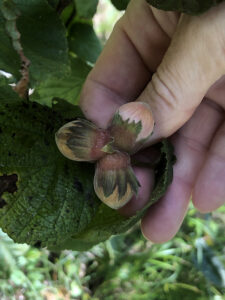
Hazel wild nuts in hand with leaf
Of the nuts, they recommend hazelnuts. These produce nuts as much younger plants than things like black walnut or pecans which are tall trees that require years to produce nuts. You need to have two or more hazelnuts as they are not self-fertile. Scott pointed out that the native species has smaller nuts than some of the named varieties.
Pecans are discussed in the book. The biggest difficulty is not growing the tree, but having a growing season long enough for the nuts to ripen. They need 150 to 180 days. But as the climate changes, perhaps this will not be a problem in 25 years. They note that you must have two compatible grafted varieties to get nuts, as the trees are not self-fertile. These are big, handsome trees and should be grown in full sun and rich soil if possible.
A tree that is not native, but produces a lot of food for deer is the Korean stone pine. The pine nuts we use for pesto is most often from these trees grown in Asia. The cones open up in winter and drop their seeds, which are rich in oil and high in calories. Scott said in Siberia tigers indirectly depend on the stone pine because they feed the deer and boar the tigers need to survive.
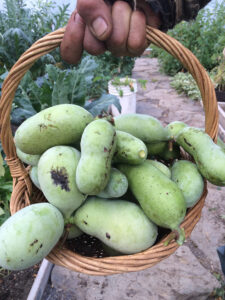
Pawpaw basket
The Hortus Arboretum and Garden is open from Mother’s Day in May until the end of October, Friday to Sunday. Admission is by donation. Because of Covid, they have been scheduling visitors on-line during the season at their website, www.Hortusgardens.org.
This book is terrifically useful to anyone interested in growing fruit and nuts. I should note that it does not cover apples, plums and peaches because those fruits are well covered by other writers, and as they say, much prone to pests and diseases. The plants discussed are generally easy to grow and trouble free. Just what we all want!
Henry is a long-time UNH Master
Gardener and author or 4
gardening books. Reach him by e-mail at
henry.homeyer@comast.net.






































